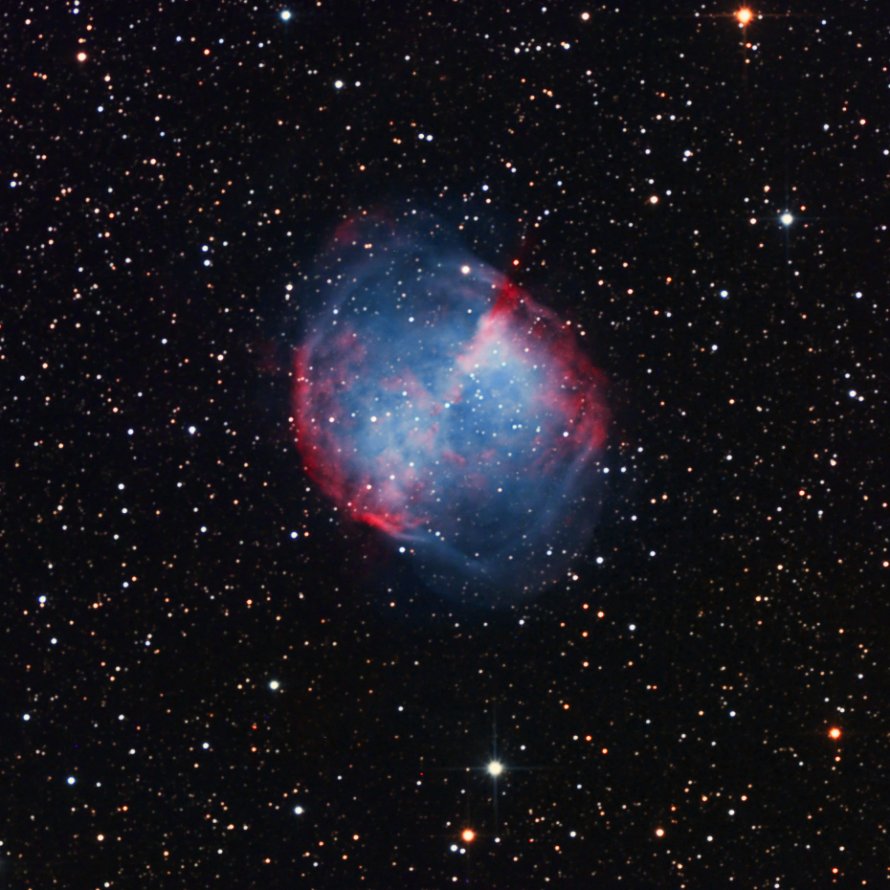M27 (NGC 6853) - Dumbbell Nebula
Messier 27 (NGC 6853), also known as the Dumbbell Nebula, is a planetary nebula located in the constellation Vulpecula, in the Orion Arm of the Milky Way Galaxy in the Local Group of galaxies. M27 is 1350 light years away from Earth.
M27 is best viewed during early spring, is magnitude 7.5, and can be viewed with binoculars. M27 is 8' x 5.6' in apparent size. For reference, the full moon is 30'.
Observing difficulty: Intermediate
- Name:
- Dumbbell Nebula
- Alt name:
- Diabolo Nebula
- Type:
- planetary nebula
- Constellation:
- Vulpecula
- NGC or IC:
- NGC 6853
- Magnitude:
- 7.5
- Viewing:
- binoculars
- Size:
- 8' x 5.6'
- Distance (light years):
- 1350 LY
- RA:
- 19h 59.6m
- Dec:
- 22 43'
- Season:
- early spring
- Milky Way location:
- Orion Arm
- Galaxy group:
- Local Group
- Messier Marathon #:
- 75
* The naked eye can see up to magnitude ~7-8 objects under ideal dark sky conditions.
A Peek into the Spectacular Dumbbell Nebula
Messier 27 (M27), also known as the Dumbbell Nebula, is a showpiece planetary nebula and a favorite among both amateur and professional astronomers. This article provides an in-depth overview of M27's discovery, its striking physical characteristics, its apparent magnitude, and offers a guide to locating and viewing this stunning nebula in the night sky.
Discovery and Observation
French astronomer Charles Messier first documented M27 in 1764, marking it as the first planetary nebula to be discovered. Residing approximately 1,360 light-years away from Earth in the constellation Vulpecula, M27 is one of the closest and most conspicuous planetary nebulae to us, making it a popular target for stargazers.
Physical Characteristics and Magnitude
The Dumbbell Nebula spans about 2.5 light-years across and gets its name from its unique double-lobed shape, resembling a dumbbell or an hourglass. The nebula is the remnants of a low-to-intermediate-mass star that has shed its outer layers towards the end of its life, leaving behind a hot, white dwarf star in the center. The gas illuminated by this central star creates the vibrant, glowing appearance of M27. With an apparent magnitude of 7.5, it's not visible to the naked eye but is easily seen through binoculars or a small telescope, revealing its prominent shape and structure.
Astronomical Significance
Planetary nebulae like M27 play a crucial role in the chemical evolution of the galaxy, returning material back into the interstellar medium that can be incorporated into future generations of stars and planetary systems. Moreover, studying M27 and similar nebulae allows astronomers to gain insight into the fate of our own Sun, which will undergo a similar process in around 5 billion years.
Finding and Viewing M27
M27 lies in the constellation Vulpecula, nestled between the constellations Cygnus and Aquila, making it best viewed during the summer months in the Northern Hemisphere. For amateur astronomers, locating the small and relatively faint constellation of Vulpecula can be a challenge, but M27 can be found about halfway between the bright stars Altair in Aquila and Deneb in Cygnus. To the eye aided by binoculars, it appears as a small, fuzzy patch, while a telescope will reveal the nebula's brighter core and its iconic dumbbell shape.



